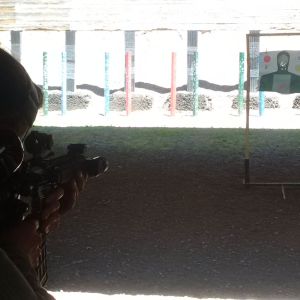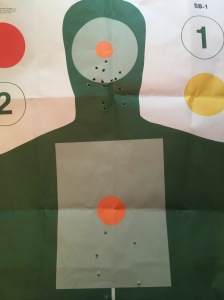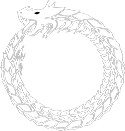Just this morning I received an e-mail from a veteran who is a long time reader of my fiction, and a follower of my training research. After a distinguished military career, he’s now doing other things which include teaching civilian CCW classes. Out of respect for his privacy, I’m going to excerpt a snippet from his e-mail here:
Marcus,
Just wanted to drop you a note to say thanks. I was filling in for a friend on a [state level] CCW class the other day and, for the first time, had two first time shooters in the class. I thought, “what the hell, let’s give it a go. I went back and pulled up the post you did on rethinking teaching the novice shooter. When it came time for the qualification shoot, I put them in the last firing order and, when everyone else was gone, I went through your method. It worked like a freakin’ charm. While they weren’t anywhere near prepared for an actual encounter with the Bad Man (no one is on a mere CCW qual course), they were shooting as well as the, ahem, “experienced” shooters in the group. So thanks. I’ll be using that again.
Can’t wait for the non-fiction books.
As I often mention in this blog, my research work in training, especially in firearms and “soft skills” like situational awareness has been adopted at the national level in Sweden, Norway, South Africa, and Israel. Individual units and regional LE/military organizations in many other countries have adopted some of it.
It’s always refreshing to me to get an e-mail like that (I consider those e-mails to be of more value than all the certificates and contracts I can hang on my wall — to me these e-mails represent lives saved now and down stream) from people out in the field. And especially so when it’s a (now) civilian instructor teaching newbie civilian shooters as I set out below in my older blog post from three or four years ago.
I’m reminded of this YouTube video on leadership. It starts off like one of my post-training parties when I was younger, and the lessons become self-evident. This very much applies to the willingness to go outside of the box, to safely experiment with new training concepts, and more to the point — be among the first to do so.
Thanks, LTC!
This post below is from 2016. The truth is out there:
Here’s a few training hacks derived from our going research (and the research of others) into training for performance under stress.
Scroll down for some recommended fundamental books that should be read by anyone who wants to discuss “cognitive neuroscience” in the context of firearms and combative training before they start slinging “most scientific” in their marketing material (hat tip to Alfred Bester in THE STARS MY DESTINATION — “Very quant! Most Scientific!”)
EXPERIENCE FOR BEGINNERS —
Whether you’re a gun enthusiast or seasoned tactician, you’ve probably run across some of the many new gun owners at ranges. Many experienced people have taken it upon themselves to offer training (familiarization) and experiences on ranges to those new to firearms. These ideas are offered from research into learning that applies to beginning firearms students.
As usual, don’t take anything said here (or by anybody) as gospel unless you verify it through your direct experience. Don’t recycle and remouth what somebody else says until you’ve done it for yourself. Feel free to read the books listed below and come to your own conclusions, or ask questions (please don’t e-mail them to me, just post in the comments, thx).
Here’s a recommended sequence of instruction for a new handgun shooter:
1. Determine status of weapon (loaded, unloaded? External safety or no? Magazine in or out, loaded or unloaded, external safety or not?
2. How to make a weapon safe: If safety,look for F/S, engage safety. Remove magazine. Lock back slide and visually/physical inspect chamber.
3. How to load the weapon.
4. Muzzle awareness — guns are geometric instruments
5. Trigger finger awareness — location of finger trigger at all time.
The only safety briefing necessary for an experienced instructor and a novice is: “Do what I tell you to do. And only that.” At this point.
The above steps are all hands on. No lecture, just show them one time, then let them do it. Don’t do it for them, let them make mistakes and figure it out by themselves. You are standing right there and you are responsible for safety. You can use snap caps/dummy rounds if you want; using real ammo under your close supervision increases stress for the student. Keep it simple, brief sentences, positive reinforcement. Don’t lecture, don’t preach. Maximize hands on by the student and hands off by the instructor. That includes talking them through. Let them figure it out. Doesn’t matter (at this point) if it looks like crap.
Once they’ve gone through this sequence above (should not take more than five to seven minutes max) go hot with the pistol. Let them do it. If somebody is really a stress wreck, load it for them and put it into their hand.
Then let them shoot. No instruction on grip, stance, aim, breathing, blah blah blah. Just make sure their fingers don’t get caught in the slide. Bring the target up close. Let them shoot like 5 rounds, take a break, shoot five more. Doesn’t matter at all what the target looks like and don’t coach. Just let them go bang. No more than ten rounds.
Then have them determine the status of their weapon, unload, make it safe.
And shake it off.
No negative comments, no coaching, no endless mouth noise about trigger control and grip and stance blah blah blah.
Then go through the whole sequence again. No talk, no lecture, just do it and let them work through the whole sequence, hands shaking whatever. It’s your job to ensure safety at this point, do so. Muzzle awareness and trigger awareness, and save the four rules lecture for another time.

Then pick ONE thing, and one thing only. I suggest starting with grip. Fine tune their grip and spend no more than one minute doing so. Don’t talk about it, just adjust their hand and have them feel whether it works for them or not.
Five shots. Let them notice improvement. If there’s no improvement by fine tuning their grip, then you better work harder as an instructor.
Then trigger. Put a coin on the front sight and have them do no more than five slow presses. if they’re able to keep the coin from falling, that’s good enough for now. No more than a minute.
Five shots.
Then stance. No more than one minute.
Five shots.
No improvement? Shame on you, instructor. There should be.
Eye-sight-target alignment. No more than one minute.
Five shots.
Take a break.
Nothing negative, just chat, let them process. No feedback from you or fine tuning at this point.
After about five minutes or so, have them go through the whole sequence (determine status, load, muzzle awareness, trigger finger, grip, stance, eye-sight-target alignment).
Shoot 10 rounds in this sequence (hat tip to Claude Werner, Tactical Professor) Fire 1 from ready, lower to low ready, fire 2, low ready, fire 3, low ready, fire 4 to slide lock, go through sequence (determine status, etc. etc.).
Take a break and congratulate them on their improvement. No improvement? Shame on you, instructor.
50 rds, about 30 minutes. See targets below.

Handgun target — 7 yards, last 25 rounds of first 50 rounds from a handgun Evah.

Student being coached by some old vagrant.

Works with ARs, too. At CQB range 10 yds — notice group on targets. First time with AR. First 20 rounds.

100 yard target.
Total AR rounds — 60 rds. Never handled one. Can identify weapon status, make safe, load, engage targets, make weapon safe. Total training time on AR platform — 30 minutes.
9mm handgun — 50 rds. Never handled one. Can identify weapon status, make safe, load, engage targets, make weapon safe. Total training time on pistol platform — 30 minutes.
One hour, 50 handgun rounds, 60 AR rounds.
Can you do this? Why not?
Dudes and dudettes, this is why this works, every single time, if you do it this way (which requires you instructor types to rethink your presuppositions, biases and perceptual framework that defines your definition of firearms instruction)
The student has no first hand experience of firearms. All her presuppositions, imagining, biases come second or third hand delivered through the opinions of others or perceptions from media like TV, movies, and the Errornet.
Biases and presuppositions come from our experiences and training. Every word that comes out of an instructors mouth comes from previous experience/learning/knowledge.
In this case, the student is a blank slate with NO EXPERIENCE to build any sort of cognitive framework on which to build a perception or to acquire skill.
So, dudes and dudettes, how about we CREATE an experience for the student, so they have some kind of cognitive framework in which to hang all the learning you expect them to get? In other words, how about building a box for them to put the learning in, and make sure that box from day one will translate to the self defense application?
Give them the experience WITHOUT you interfering, only guiding and doing the minimal necessary to provide safety (you’re responsible during this particular first session). Let them work through errors on their own. Then get on with it.
So here’s an example: devout Muslims and Orthodox Jews. The subject of your lecture? The Joy of Virginia Ham. So you gots your PowerPoint, you gots your training AIDS, you gots your lecture notes all set out. So now…describe the taste of Virginia Ham to an audience that has no experience with eating ham.
C’mon, you’re an instructor. What’s so tough about that?
So now explain (use your words, now, as my fellow FLETC instructor Raylan Givens once said), to an audience with no experience with real firearms or shooting. Use your words only. Now go have them do what you TALKED about. Or maybe skip the lectures till you BUILD a cognitive framework based on EXPERIENCE so the students can then hang your abstractions and lecture onto their experiential framework.
START WITH THESE BOOKS TO RESHAPE YOUR BELIEFS ABOUT WHAT IS POSSIBLE IF YOU MODIFY YOUR APPROACH TO FIREARMS TRAINING. OR DON’T.

Now I’m sure I’m going to get the usual rash of complaints about not citing my company research or the recent research that supports this. So here’s a challenge to those usual suspects: GO DO THIS. TRY IT OUT IN THE REAL WORLD. MAKE IT WORK. THEN, WHEN YOU HAVE THE EXPERIENCE, ASSUMING YOU’RE WILLING TO RESHAPE YOUR BELIEF ABOUT WHAT IS POSSIBLE, THEN READ THOSE BOOKS FOR AN EXCELLENT SNAPSHOT ABOUT WHAT IS FAIRLY CURRENT IN COGNITIVE NEUROSCIENCE AND PERFORMANCE UNDER STRESS, AND THEN FOLLOW THE RESEARCH IN THOSE BIBLIOGRAPHIES.
And then ask yourself this question: What’s more important in a gunfight? Being able to rattle off cognitive neuroscience, or do the skill in real time under real stress? What’s more important to a teacher of gun fighting? The ability to rattle off “Yerkes-Dodson! Hicks Law! Most scientific!” Or the ability to take a chance and reshape the paradigm of firearms training which dates back to the 1700s and incorporate some simple and extremely proven research (which is just now creeping into firearms training) so that you can SAVE SOME LIVES and make sure that new shooters start off right?
Food for thought, dudes and dudettes.
Have a good ‘un.
PS: Shout out to the Achy Man haters! Hope you’re enjoying yourselves in Minnesota! Drop by any time, and bring your catamites — we’re very gay-friendly in Minneapolis. Say hi to Uncle Rico next time!
PPS: Go here for a free e-book/Kindle copy of my best selling first novel NO OTHER OPTION. Free till Wednesday! https://www.amazon.com/gp/product/B004YKUE6M/ref=dbs_a_def_rwt_hsch_vapi_taft_p1_i1

